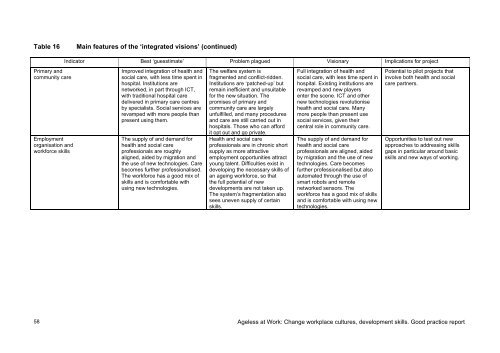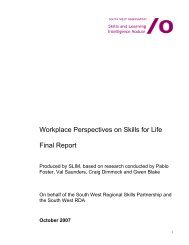Ageless at Work - Skills for Care
Ageless at Work - Skills for Care
Ageless at Work - Skills for Care
Create successful ePaper yourself
Turn your PDF publications into a flip-book with our unique Google optimized e-Paper software.
Table 16<br />
Main fe<strong>at</strong>ures of the ‘integr<strong>at</strong>ed visions’ (continued)<br />
Indic<strong>at</strong>or Best ‘guesstim<strong>at</strong>e’ Problem plagued Visionary Implic<strong>at</strong>ions <strong>for</strong> project<br />
Primary and<br />
community care<br />
Employment<br />
organis<strong>at</strong>ion and<br />
work<strong>for</strong>ce skills<br />
Improved integr<strong>at</strong>ion of health and<br />
social care, with less time spent in<br />
hospital. Institutions are<br />
networked, in part through ICT,<br />
with traditional hospital care<br />
delivered in primary care centres<br />
by specialists. Social services are<br />
revamped with more people than<br />
present using them.<br />
The supply of and demand <strong>for</strong><br />
health and social care<br />
professionals are roughly<br />
aligned, aided by migr<strong>at</strong>ion and<br />
the use of new technologies. <strong>Care</strong><br />
becomes further professionalised.<br />
The work<strong>for</strong>ce has a good mix of<br />
skills and is com<strong>for</strong>table with<br />
using new technologies.<br />
The welfare system is<br />
fragmented and conflict-ridden.<br />
Institutions are ‘p<strong>at</strong>ched-up’ but<br />
remain inefficient and unsuitable<br />
<strong>for</strong> the new situ<strong>at</strong>ion. The<br />
promises of primary and<br />
community care are largely<br />
unfulfilled, and many procedures<br />
and care are still carried out in<br />
hospitals. Those who can af<strong>for</strong>d<br />
it opt out and go priv<strong>at</strong>e.<br />
Health and social care<br />
professionals are in chronic short<br />
supply as more <strong>at</strong>tractive<br />
employment opportunities <strong>at</strong>tract<br />
young talent. Difficulties exist in<br />
developing the necessary skills of<br />
an ageing work<strong>for</strong>ce, so th<strong>at</strong><br />
the full potential of new<br />
developments are not taken up.<br />
The system’s fragment<strong>at</strong>ion also<br />
sees uneven supply of certain<br />
skills.<br />
Full integr<strong>at</strong>ion of health and<br />
social care, with less time spent in<br />
hospital. Existing institutions are<br />
revamped and new players<br />
enter the scene. ICT and other<br />
new technologies revolutionise<br />
health and social care. Many<br />
more people than present use<br />
social services, given their<br />
central role in community care.<br />
The supply of and demand <strong>for</strong><br />
health and social care<br />
professionals are aligned, aided<br />
by migr<strong>at</strong>ion and the use of new<br />
technologies. <strong>Care</strong> becomes<br />
further professionalised but also<br />
autom<strong>at</strong>ed through the use of<br />
smart robots and remote<br />
networked sensors. The<br />
work<strong>for</strong>ce has a good mix of skills<br />
and is com<strong>for</strong>table with using new<br />
technologies.<br />
Potential to pilot projects th<strong>at</strong><br />
involve both health and social<br />
care partners.<br />
Opportunities to test out new<br />
approaches to addressing skills<br />
gaps in particular around basic<br />
skills and new ways of working.<br />
58<br />
<strong>Ageless</strong> <strong>at</strong> <strong>Work</strong>: Change workplace cultures, development skills. Good practice report








